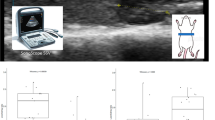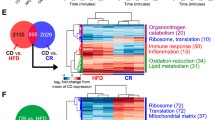Abstract
Metabolic perturbations resulting from excessive hepatic fat accumulation are poorly understood. Thus, in this study, leptin-deficient ob/ob mice, a mouse model of fatty liver disease, were used to investigate metabolic alterations in more detail. Metabolites were quantified in intact liver tissues of ob/ob (n = 8) and control (n = 8) mice using high-resolution magic angle spinning (HR-MAS) 1H-NMR. In addition, after demonstrating that HR-MAS 1H-NMR does not affect RNA integrity, transcriptional changes were measured by quantitative real-time PCR on RNA extracted from the same specimens after HR-MAS 1H-NMR measurements. Importantly, the gene expression changes obtained agreed with those observed by Affymetrix microarray analysis performed on RNA isolated directly from fresh-frozen tissue. In total, 40 metabolites could be assigned in the spectra and subsequently quantified. Quantification of lactate was also possible after applying a lactate-editing pulse sequence that suppresses the lipid signal, which superimposes the lactate methyl resonance at 1.3 ppm. Significant differences were detected for creatinine, glutamate, glycine, glycolate, trimethylamine-N-oxide, dimethylglycine, ADP, AMP, betaine, phenylalanine, and uridine. Furthermore, alterations in one-carbon metabolism, supported by both metabolic and transcriptional changes, were observed. These included reduced demethylation of betaine to dimethylglycine and the reduced expression of genes coding for transsulfuration pathway enzymes, which appears to preserve methionine levels, but may limit glutathione synthesis. Overall, the combined approach is advantageous as it identifies changes not only at the single gene or metabolite level but also deregulated pathways, thus providing critical insight into changes accompanying fatty liver disease.

A Evaluation of RNA integrity before and after HR-MAS 1H-NMR of intact mouse liver tissue. B Metabolite concentrations and gene expression levels assessed in ob/ob (steatotic) and ob/+ (control) mice using HR-MAS 1H-NMR and qRT-PCR, respectively.






Similar content being viewed by others
References
Nagarajan P, Kumar MJM, Venkatesan R, Majundar SS, Hyal RC. Genetically modified mouse models for the study of nonalcoholic fatty liver disease. World J Gastroenterol. 2012;18(11):1141–53. doi:10.3748/wjg.v18.i11.1141.
Liu Q, Bengmark S, Qu S. The role of hepatic fat accumulation in pathogenesis of non-alcoholic fatty liver disease (NAFLD). Lipids Health Dis. 2010;9(42):1–9. doi:10.1186/1476-511X-9-42.
Takahashi Y, Soejima Y, Fukusato T. Animal models of nonalcoholic fatty liver disease/nonalcoholic steatohepatitis. World J Gastroenterol. 2012;18(19):2300–8. doi:10.3748/wjg.v18.i19.2300.
Sitter B, Lundgren S, Bathen TF, Halgunset J, Fjosne HE, Gribbestad IS. Comparison of HR MAS MR spectroscopic profiles of breast cancer tissue with clinical parameters. NMR Biomed. 2006;19(1):30–40. doi:10.1002/nbm.992.
Choi JS, Baek HM, Kim S, Kim MJ, Youk JH, Moon HJ, et al. HR-MAS MR spectroscopy of breast cancer tissue obtained with core needle biopsy: correlation with prognostic factors. PLoS ONE. 2012;7(12):1–9. doi:10.1371/journal.pone.0051712.
Cao MD, Sitter B, Bathen TF, Bofin A, Lonning PE, Lundgren S, et al. Predicting long-term survival and treatment response in breast cancer patients receiving neoadjuvant chemotherapy by MR metabolic profiling. NMR Biomed. 2012;25(2):369–78. doi:10.1002/nbm.1762.
Swanson MG, Zektzer AS, Tabatabai ZL, Simko J, Jarso S, Keshari KR, et al. Quantitative analysis of prostate metabolites using 1H HR-MAS spectroscopy. Magn Reson Med. 2006;55(6):1257–64. doi:10.1002/mrm.20909.
Opstad KS, Bel BA, Griffiths JR, Howe FA. An investigation of human brain tumour lipids by high-resolution magic angle spinning 1H MRS and histological analysis. NMR Biomed. 2008;21(7):677–85. doi:10.1002/nbm.1239.
Santos CF, Kurhanewicz J, Tabatabai ZL, Simko JP, Keshari KR, Gbegnon A, et al. Metabolic, pathologic, and genetic analysis of prostate tissues: quantitative evaluation of histopathologic and mRNA integrity after HR-MAS spectroscopy. NMR Biomed. 2010;23(4):391–8. doi:10.1002/nbm.1474.
He QH, Shungu DC, Vanzijl PCM, Bhujwalla ZM, Glickson JD. Single-scan in-vivo lactate editing with complete lipid and water suppression by selective multiple-quantum-coherence transfer (Sel-Mqc) with application to tumors. J Magn Reson Ser B. 1995;106(3):203–11. doi:10.1006/jmrb.1995.1035.
Boer VO, Luijten PR, Klomp DWJ. Refocused double-quantum editing for lactate detection at 7 T. Magn Reson Med. 2013;69(1):1–6. doi:10.1002/mrm.24227.
Holbach M, Lambert J, Suter D. Optimized multiple-quantum filter for robust selective excitation of metabolite signals. J Magn Reson. 2014;243:8–16. doi:10.1016/j.jmr.2014.03.007.
Holbach M, Lambert J, Johst S, Ladd ME, Suter D. Optimized selective lactate excitation with a refocused multiple-quantum filter. J Magn Reson. 2015;255:34–8. doi:10.1016/j.jmr.2015.03.004.
Schroeder A, Mueller O, Stocker S, Salowsky R, Leiber M, Gassmann M, et al. The RIN: an RNA integrity number for assigning integrity values to RNA measurements. BMC Mol Biol. 2006;7(3):1–14. doi:10.1186/1471-2199-7-3.
Godoy P, Widera A, Schmidt-Heck W, Campos G, Meyer C, Cadenas C, et al. Gene network activity in cultivated primary hepatocytes is highly similar to diseased mammalian liver tissue. Arch Toxicol. 2016;90(10):2513–29. doi:10.1007/s00204-016-1761-4.
Irizarry RA, Hobbs B, Collin F, Beazer-Barclay YD, Antonellis KJ, Scherf U, et al. Exploration, normalization, and summaries of high density oligonucleotide array probe level data. Biostatistics. 2003;4(2):249–64. doi:10.1093/biostatistics/4.2.249.
Smyth GK, Michaud J, Scott HS. Use of within-array replicate spots for assessing differential expression in microarray experiments. Bioinformatics. 2005;21(9):2067–75. doi:10.1093/bioinformatics/bti270.
Benjamini Y, Hochberg Y. Controlling the false discovery rate—a practical and powerful approach to multiple testing. J Roy Stat Soc B Met. 1995;57(1):289–300.
Borgan E, Sitter B, Lingjaerde OC, Johnsen H, Lundgren S, Bathen TF et al. Merging transcriptomics and metabolomics—advances in breast cancer profiling. BMC Cancer. 2010;10(628):1–14. doi:10.1186/1471-2407-10-628.
Tufts L, Vishnudas KS, Fu E, Kurhanewicz J, Ries M, Alliston T, et al. Correlating high-resolution magic angle spinning NMR spectroscopy and gene analysis in osteoarthritic cartilage. NMR Biomed. 2015;28(5):523–8. doi:10.1002/nbm.3285.
Yang JS, Kim JT, Jeon J, Park HS, Kang GH, Park KS, et al. Changes in hepatic gene expression upon oral administration of taurine-conjugated ursodeoxycholic acid in ob/ob mice. PLoS ONE. 2010;5(11):1–10. doi:10.1371/journal.pone.0013858.
Zhang J, Wu Y, Zhang Y, Leroith D, Bernlohr DA, Chen X. The role of lipocalin 2 in the regulation of inflammation in adipocytes and macrophages. Mol Endocrinol. 2008;22(6):1416–26. doi:10.1210/me.2007-0420.
Xu N, Nilsson-Ehle P, Hurtig M, Ahren B. Both leptin and leptin-receptor are essential for apolipoprotein M expression in vivo. Biochem Biophys Res Commun. 2004;321(4):916–21. doi:10.1016/j.bbrc.2004.06.180.
Wang YQ, Van Oort MM, Yao MH, Van der Horst DJ, Rodenburg KW. Insulin and chromium picolinate induce translocation of CD36 to the plasma membrane through different signaling pathways in 3T3-L1 adipocytes, and with a differential functionality of the CD36. Biol Trace Elem Res. 2011;142(3):735–47. doi:10.1007/s12011-010-8809-8.
Steinbusch LKM, Schwenk RW, Ouwens DM, Diamant M, Glatz JFC, Luiken JJFP. Subcellular trafficking of the substrate transporters GLUT4 and CD36 in cardiomyocytes. Cell Mol Life Sci. 2011;68(15):2525–38. doi:10.1007/s00018-011-0690-x.
Miyazaki M, Dobrzyn A, Elias PM, Ntambi JM. Stearoyl-CoA desaturase-2 gene expression is required for lipid synthesis during early skin and liver development. Proc Natl Acad Sci U S A. 2005;102(35):12501–6. doi:10.1073/pnas.0503132102.
Ntambi JM, Miyazaki A, Dobrzyn A. Regulation of stearoyl-CoA desaturase expression. Lipids. 2004;39(11):1061–5. doi:10.1007/s11745-004-1331-2.
VerHague MA, Cheng DM, Weinberg RB, Shelness GS. Apolipoprotein A-IV expression in mouse liver enhances triglyceride secretion and reduces hepatic lipid content by promoting very low density lipoprotein particle expansion. Arterioscler Throm Vasc Biol. 2013;33(11):2501–8. doi:10.1161/Atvbaha.113.301948.
Williams KT, Schalinske KL. New insights into the regulation of methyl group and homocysteine metabolism. J Nutr. 2007;137(2):311–4.
Lee JH, Friso S, Choi SW. Epigenetic mechanisms underlying the link between non-alcoholic fatty liver diseases and nutrition. Nutrients. 2014;6(8):3303–25. doi:10.3390/nu6083303.
McBean GJ. The transsulfuration pathway: a source of cysteine for glutathione in astrocytes. Amino Acids. 2012;42(1):199–205. doi:10.1007/s00726-011-0864-8.
Serviddio G, Blonda M, Bellanti F, Villani R, Iuliano L, Vendemiale G. Oxysterols and redox signaling in the pathogenesis of non-alcoholic fatty liver disease. Free Radic Res. 2013;47(11):881–93. doi:10.3109/10715762.2013.835048.
Kempson SA, Zhou Y, Danbolt NC. The betaine/GABA transporter and betaine: roles in brain, kidney, and liver. Front Physiol. 2014;5(159):1–16. doi:10.3389/fphys.2014.00159.
Wagner CA, Lukewille U, Kaltenbach S, Moschen I, Broer A, Risler T, et al. Functional and pharmacological characterization of human Na+-carnitine cotransporter hOCTN2. Am J Phys Renal. 2000;279(3):F584–91.
Beard RS, Bearden SE. Vascular complications of cystathionine beta-synthase deficiency: future directions for homocysteine-to-hydrogen sulfide research. Am J Phys Heart C. 2011;300(1):H13–26. doi:10.1152/ajpheart.00598.2010.
Willebrords J, Pereira IVA, Maes M, Yanguas SC, Colle I, Van Den Bossche B, et al. Strategies, models and biomarkers in experimental non-alcoholic fatty liver disease research. Prog Lipid Res. 2015;59:106–25. doi:10.1016/j.plipres.2015.05.002.
Del Chierico F, Nobili V, Vernocchi P, Russo A, De Stefanis C, Gnani, et al. Gut microbiota profiling of pediatric NAFLD and obese patients unveiled by an integrated meta-omics based approach. Hepatology. 2016. doi:10.1002/hep.28572.
Martel C, Degli Esposti D, Bouchet A, Brenner C, Lemoine A. Non-alcoholic steatohepatitis: new insights from OMICS studies. Curr Pharm Biotechnol. 2012;13(5):726–35.
Li HK, Xie ZQ, Lin JC, Song HG, Wang Q, Wang K, et al. Transcriptomic and metabonomic profiling of obesity-prone and obesity-resistant rats under high fat diet. J Proteome Res. 2008;7(11):4775–83. doi:10.1021/pr800352k.
Beckonert O, Keun HC, Ebbels TMD, Bundy JG, Holmes E, Lindon JC, et al. Metabolic profiling, metabolomic and metabonomic procedures for NMR spectroscopy of urine, plasma, serum and tissue extracts. Nat Protoc. 2007;2(11):2692–703. doi:10.1038/nprot.2007.376.
Naz S, Garcia A, Barbas C. Multiplatform analytical methodology for metabolic fingerprinting of lung tissue. Anal Chem. 2013;85(22):10941–8. doi:10.1021/ac402411n.
Wu H, Xue RY, Lu CL, Deng CH, Liu TT, Zeng HZ, et al. Metabolomic study for diagnostic model of oesophageal cancer using gas chromatography/mass spectrometry. J Chromatogr B. 2009;877(27):3111–7. doi:10.1016/j.jchromb.2009.07.039.
Hirayama A, Kami K, Sugimoto M, Sugawara M, Toki N, Onozuka H, et al. Quantitative metabolome profiling of colon and stomach cancer microenvironment by capillary electrophoresis time-of-flight mass spectrometry. Cancer Res. 2009;69(11):4918–25. doi:10.1158/0008-5472.CAN-08-4806.
Gowda GAN, Raftery D. Can NMR solve some significant challenges in metabolomics? J Magn Reson. 2015;260:144–60. doi:10.1016/j.jmr.2015.07.014.
Giesbertz P, Padberg I, Rein D, Ecker J, Hofle A, Spanier B, et al. Metabolite profiling in plasma and tissues of ob/ob and db/db mice identifies novel markers of obesity and type 2 diabetes. Diabetologia. 2015;58(9):2133–43. doi:10.1007/s00125-015-3656-y.
Bravo E, Palleschi S, Aspichueta P, Buque X, Rossi B, Cano A, et al. High fat diet-induced non alcoholic fatty liver disease in rats is associated with hyperhomocysteinemia caused by down regulation of the transsulphuration pathway. Lipids Health Dis. 2011;10(60):1–6. doi:10.1186/1476-511X-10-60.
Niu SW, Wang LQ, He M, Peng YZ, Li SD. Exendin-4 regulates redox homeostasis in rats fed with high-fat diet. Acta Biochim Biophys Sin. 2015;47(6):397–403. doi:10.1093/abbs/gmv027.
Murray TVA, Dong XB, Sawyer GJ, Caldwell A, Halket J, Sherwood R, et al. NADPH oxidase 4 regulates homocysteine metabolism and protects against acetaminophen-induced liver damage in mice. Free Radic Biol Med. 2015;89:918–30. doi:10.1016/j.freeradbiomed.2015.09.015.
Miller CM, Szegedi SS, Garrow TA. Conformation-dependent inactivation of human betaine-homocysteine S-methyltransferase by hydrogen peroxide in vitro. Biochem J. 2005;392:443–8. doi:10.1042/Bj20050356.
Castro C, Millian NS, Garrow TA. Liver betaine-hornocysteine S-methyltransferase activity undergoes a redox switch at the active site zinc. Arch Biochem Biophys. 2008;472(1):26–33. doi:10.1016/j.abb.2008.01.017.
Fernandez-Roig S, Cavalle-Busquets P, Fernandez-Ballart JD, Ballesteros M, Berrocal-Zaragoza MI, Salat-Batlle J, et al. Low folate status enhances pregnancy changes in plasma betaine and dimethylglycine concentrations and the association between betaine and homocysteine. Am J Clin Nutr. 2013;97(6):1252–9. doi:10.3945/ajcn.112.054189.
Innis SM, Hasman D. Evidence of choline depletion and reduced betaine and dimethylglycine with increased homocysteine in plasma of children with cystic fibrosis. J Nutr. 2006;136(8):2226–31.
McGregor DO, Dellow WJ, Lever M, George PM, Robson RA, Chambers ST. Dimethylglycine accumulates in uremia and predicts elevated plasma homocysteine concentrations. Kidney Int. 2001;59(6):2267–72. doi:10.1046/j.1523-1755.2001.0590062267.x.
Day CR, Kempson SA. Betaine chemistry, roles, and potential use in liver disease. BBA-Gen Subjects. 2016;1860(6):1098–106. doi:10.1016/j.bbagen.2016.02.001.
Schafer C, Hoffmann L, Heldt K, Lornejad-Schafer MR, Brauers G, Gehrmann T, et al. Osmotic regulation of betaine homocysteine-S-methyltransferase expression in H4IIE rat hepatoma cells. Am J Phys Gastrointest Liver. 2007;292(4):G1089–98. doi:10.1152/ajpgi.00088.2006.
Acknowledgements
We thank Agapios Sachinidis at the Center of Physiology and Pathophysiology of the Medical Faculty at the University of Cologne for performing the gene microarray analysis. Financial support by the Ministerium für Innovation, Wissenschaft und Forschung des Landes Nordrhein-Westfalen, the Senatsverwaltung für Wirtschaft, Technologie und Forschung des Landes Berlin, and the Bundesministerium für Bildung und Forschung (01KU1216I) is gratefully acknowledged.
Author information
Authors and Affiliations
Corresponding author
Ethics declarations
Conflict of interest
The authors declare that they have no conflict of interest.
Additional information
Roland Hergenröder and Cristina Cadenas contributed equally to this work.
Electronic supplementary material
Below is the link to the electronic supplementary material.
ESM 1
(PDF 1274 kb)
Rights and permissions
About this article
Cite this article
Gogiashvili, M., Edlund, K., Gianmoena, K. et al. Metabolic profiling of ob/ob mouse fatty liver using HR-MAS 1H-NMR combined with gene expression analysis reveals alterations in betaine metabolism and the transsulfuration pathway. Anal Bioanal Chem 409, 1591–1606 (2017). https://doi.org/10.1007/s00216-016-0100-1
Received:
Revised:
Accepted:
Published:
Issue Date:
DOI: https://doi.org/10.1007/s00216-016-0100-1




